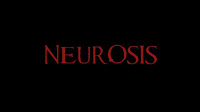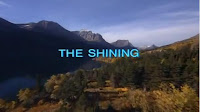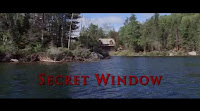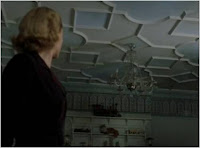In what ways does your media product use, develop or challenge forms and conventions of real media products?
Titling

The main title of our production is presented over a black screen, in a red font. The title appears on screen for around three seconds, about 54 seconds into the opening twominutes. Before we decided to create our main title in the way we did, we had to research other films of the psychological thriller genre to identify the typical codes and conventions. 'In the film The Shining' the main title is presented over the image of the film:

This technique helps the audience to establish the setting of the film. However other films I looked at such as 'The Butterfly Effect', displays the main title over a black screen:
From looking at these films as well as others, it seemed that the typical conventions of a psychological thriller are either the title presented over the image, or over a black screen. So in this way, we are following the conventions of this genre of film. In terms of the colour of our font being red, it seemed that common colours for the main titles were blue and red. For example, the titles in 'The Shining' and 'The Butterfly Effect' are both blue, and I found that the title in 'The Secret Window' is displayed in red:

The font of our main title in our production is red, and inappropriate font for the genre of our film. In this way we used the typical codes and conventions of the psychological thriller genre. We also chose to display our main title in this way because we believed that having the title over a black screen and in a prominent colour would attract audience attention to the significance of the title.
Camera Movement
In the film 'The Secret Window' there is a zooming in shot of the main character. This not only highlights the character as a key role to the audience, but also symbolises the audience going into the mind of the character. The mind is an important concept in a psychological thriller and so we thought this was quite an important convention to imitate. In our production we used a zooming in shot at the end of our opening two minutes, going into Horatio's eyes, meaning the audience would establish Horatio's character and take a step into his mind and intentions.

Still from 'The Secret Window'
Still from 'Neurosis'
Framing of Shots


In 'The Other's and 'The Ring' there are lots of close-ups and medium close-ups of characters faces; these show their facial expressions well and allow the audience to interpret their moods. 'The Others' also shows an over-the-shoulder shot of one of the main characters, allowing the audience to follow her eye level and see what she is seeing in the background:

In our production we also used a medium close-up of our main character at the end of our opening two minutes, showing how we used this convention of a psychological thriller. As well as this we used an over-the-shoulder shot when Horatio is typing up the article of Mia, to allow the audience to see what he is seeing.
Camera Angles
In 'Hide and Seek' and 'The Butterfly Effect', low camera angles are used. Low camera angles give the audience a feeling of speed and movement, and also produce in the audience feelings of confusion and powerlessness as well as feeling dominated by the action in the scene.
In our production we challenged these codes and conventions of the psychological thriller genre. We kept the camera in a statutory position in most of the shots. By keeping the camera statutory, especially on the shots of Horatio, we conveyed the idea that he is a key character and will remain throughout the film.
Mise-en-scene
In 'The Ring' and 'The Others' there is a lot of low-key lighting used, as well as settings of domestic locations, such as within houses. The low-key lighting creates a sinister and eerie mood, whereas the domestic settings make the audience feel suspenseful and as it they're waiting for something to happen. This creates an equilibrium which is then disrupted, making the film more frightening.
In our production we used these conventions of a psychological thriller. We used low-key lighting when Horatio is in the newsroom to create a sinister atmosphere, as this is when the audience start to get an idea of Horatio's intentions. All our settings were also conventional, every day settings; such as Welham Road when Horatio is following Mia.
Editing Directions
I noticed that films of the psychological thriller genre had lots of dialogue between characters in which reverse shots were used, in order to show both characters' facial expressions and moods to the audience. In 'The Secret Window' and 'The Ring' there are a lot of reverse shots with short cutting rhythm, as well as some reaction shots. Reaction shots are effective in this genre as they are very successful in creating suspense in the audience, through the characters' uneasiness and suspense.


In our production, we challenged this aspect of the conventions of the psychological thriller genre. We did not use any reaction shots or reverse shots in our opening two minutes, and our cutting rhythm was also slightly longer. We did not use any reverse shots due to us having no dialogue in the opening two minutes, and we also wanted to create a more mysterious opening, by not having any dialogue; meaning the audience can concentrate more on the action of the film and try to interpret Horatio's intentions.
Sound Techniques
In 'The Ring' there is diegetic sounds such as rain or TV noise, these help to set the scene and create atmosphere. Whereas, in 'Hide and Seek' eerie music is used to create a creepy atmosphere, even in situations that would normally seem harmless. It seemed that diegetic sound and non-diegetic sound are used in this genre to create atmosphere in different ways; often diegetic is used in domestic situations, underneath dialogue, to set the scene, and non-diegetic sound is often used to create an eerie or sinister atmosphere, even withing ordinary situations.

We used some of these conventions in our production, but also challenged others. We used non-diegetic sound in terms of eerie music, to create atmosphere, and also carried the music across each scene, creating a sound-bridge, which links the scenes together and suggests to the audience that they are all linked and essential to the rest of the story-line. However, we did not use any diegetic sound in our production to help set the scene, as we wanted the opening two minutes to be more of an introduction of the story to the audience, and for them to gather an interpretation of Horatio's intentions, and possible outcomes in the story through the first two minutes of our production.

.jpg)

 The Distribution Company we chose to distribute our film was Fox Searchlight Pictures. We decided to choose Fox Searchlight Pictures as the distribution company of our film for various reasons. The company specialises in British and Indie films, and also distributed the psychological thriller film, 'One Hour Photo'. As our film is a British film we thought a company that speciliases in British and Indie films would be a good choice of distribution company.
The Distribution Company we chose to distribute our film was Fox Searchlight Pictures. We decided to choose Fox Searchlight Pictures as the distribution company of our film for various reasons. The company specialises in British and Indie films, and also distributed the psychological thriller film, 'One Hour Photo'. As our film is a British film we thought a company that speciliases in British and Indie films would be a good choice of distribution company. 

















